12/8
We often had to be really careful as we walked along the embankment because of the number of goats and cows who had free reign of the place!
Bathing in the Ganges.
Lali Ghat: More laundry was being washed here in front of the ghat.
Hanuman Ghat was built by Lord
Ram and dedicated to his favorite disciple Hanuman, a symbol of strength. As a
result there are often local wrestlers and body builders there but we didn’t
see any.
The priest (?), above, rearranged all the rice to make a new design for me after he noticed my admiring, and taking pictures of, the first one he had made. I was so touched by his thoughtfulness.
The redesigned pattern of rice done on my behalf.
Our achy, breaky knees walking up and down all those steps - thank goodness we had enjoyed seeing the Jain Ghat!
While wandering from ghat to ghat along the river, we had to be really careful of kids playing cricket. I learned that a little late though after I got beaned hard in the chest by an errant tennis ball! We also got our feet entangled in kite strings that had been left on the ground ready to ensnare unsuspecting passersby.
Photos of Durga Temple below:
Seeing all the cows rummaging through the garbage pile would be just your style, Janina, right!
The driver got quite frustrated though with just how heavy the traffic was and kept having to go on side streets to try and get away from the stalled traffic. After all his griping that we’d never get there though, it only took him an extra 10 minutes.
After walking through the excavated areas and looking at the
pillaged remains of the Dharmarajika Stupa, we walked to Dhamek Stupa, above, also within the park, next.
Information about Jainism if you're interested.
The shoe attendant.
Photos from nearby Mulagandha Temple:
Built in 1931, the temple had marvelous frescoes by a Japanese artist depicting scenes from the life of Buddha.
We made our way next to the most sacred place for Buddhists in India where Buddha gave his first sermon. Photos from the Buddha Complex:
Varanasi
I understand that it may seem bizarre that we were able to achieve a sense of peace while watching from our perch above the Ganges bodies being burned in a dozen or more funeral pyres below us on the banks of the Ganges - I think it was a matter of your needing to be there to understand. It was well after dusk by then and a pall of heavy smoke from the wood fires clung on the cool air.
We had heard that flights to and from Varanasi in the
wintertime are often delayed for hours because of fog that blankets the city
all winter and that even trains are likewise delayed for up to a mind boggling
20 hours too. How depressing, I thought, living in a climate that sees little
to no sun for such long stretches of time.
As yesterday afternoon and last night we had walked north along the Ganges ,
this morning we walked in the opposite direction along the Ganges so we could see different ghats .
Photos of our walk along the Ganges by the ghats:
Dhobis – washer men and women - did early morning laundry here by beating the clothes against the stones in the Ganges.
We often had to be really careful as we walked along the embankment because of the number of goats and cows who had free reign of the place!
Chauki Ghat: We saw lots of stone figures of snakes under
the huge ficus tree at the top of the steps in the photos above and below.
Above and below, boat building by Kedar Ghat.
Bathing in the Ganges.
Lali Ghat: More laundry was being washed here in front of the ghat.
We then saw another ‘burning' ghat, Harish Chandra,
although it had been modernized and also had an electric crematorium.
Saw signs for other ghats,
even in Hebrew above, as we continued walking further south. Steven and I
were surprised that a lot of Israeli tourists came to Varanasi .
Shivali Ghat was built in 1770 by Chet Singh, the
maharaja of Varanasi . I loved the name given below to the garbage can there!
Chet Singh Ghat: The reddish color of the massive fort
at Chet Singh Ghat stood out. There weren’t many bathers there as many believe
the currents are too dangerous here. The ghat was historically notable as being
the spot where the maharaja of Varanasi
was defeated by the British in the mid 1800s.
Jain Ghat: Previously part of the adjoining ghat, the
Jains made this their own in the early twentieth century.
Photos of the Jain Ghat below:
Photos of the Jain Ghat below:
The redesigned pattern of rice done on my behalf.
Our achy, breaky knees walking up and down all those steps - thank goodness we had enjoyed seeing the Jain Ghat!
How incongruous seeing a replica of the Eiffel
Tower Varanasi ,
was named for a great sixteenth century Hindu poet who wrote an epic while
staying in the city. Legend has it that the manuscript fell into the water but
didn’t sink. It floated instead and was saved.
While wandering from ghat to ghat along the river, we had to be really careful of kids playing cricket. I learned that a little late though after I got beaned hard in the chest by an errant tennis ball! We also got our feet entangled in kite strings that had been left on the ground ready to ensnare unsuspecting passersby.
We reached the southernmost ghat, Assi Ghat by noon , about 90 minutes after setting out that
morning. The ghat marks the location where the Assi
River Ganges
meet. After walking up all the ghat steps, we got a tuk tuk to drive us
to Durga Temple
Photos of Durga Temple below:
The eighteenth century shrine was dedicated to the goddess
Durga. The multi leveled spire - five lower ones and one on top – symbolized
the belief that the five elements of the world (air, earth, water, fire and
ether) merge with the Supreme.
Every bell was being rung constantly so there was quite a
din.
Only Hindus could enter the temple itself, above, but the courtyard
was accessible to all.
The women sprinkled powder on the faithful.
We were surprised that Durga Temple was packed on a Tuesday
at lunchtime – don’t know whether it was always like that or only during the
lunch hour.
We noticed people paying homage to the holy man above in between
his talking on his cell phone!
As people entered and exited the temple, they knelt and
kissed this area.
This couple entered Durga Temple as we left it.
We negotiated with the driver to take us to Sarnath,
a town just 10kms away, but he said it would take him an hour to get there as it
was ‘wedding season’ in Varanasi .
That meant the traffic would be horrendous as there were so many more people on
the roads who came from far and wide to attend wedding ceremonies. He agreed on
the 500 Indian rupee price (about $7.50) which would also entail his waiting
for us for about 2 hours while we walked around Sarnath and then driving us
back to Varanasi .
Photos en route to Sarnath:
Seeing all the cows rummaging through the garbage pile would be just your style, Janina, right!
Sarnath is a Buddhist pilgrimage center as it was there
around 530 BC, that Buddha, just 5 weeks after he had found enlightenment, gave
his first sermon called 'The Setting in Motion of the Wheel of Motion.' According to Buddhist belief, this set in motion a new cycle of
rebirths and reincarnations leading eventually to ultimate enlightenment for
everybody. During the rainy season, when Buddha and his followers sought a
break from their itinerant round of teaching, they would retire in Sarnath.
Over the centuries, Sarnath flourished as a center of
Buddhist art and teaching. But with the impact of Muslim invasions and the rise
of Hinduism, Sarnath’s expanding Buddhist settlement eventually dissolved and
much of the site lay in ruins until 1834 when it was excavated. A stone slab
was found with an inscription of the Buddhist creed and numerous other relics
were also found. It was then that the Western world realized that the Buddha
had been an actual person and not a mythical figure. Now Sarnath is again an
important Buddhist center and home to Buddhist missions from all over the
world.
Our first stop was at the Thai
Temple
How wonderful seeing flowers again after all the dirt,
trash, animals and their excrement.
We then strolled up the street and bought admission tickets so we
could view the extensive archeological excavations of the main site of Sarnath which
were maintained in an immaculate park.
Photos of Dharmarajika Stupa:
Dharmarajika is attributed to the reign of Ashoka in
the third century BC but it was extended a further 6 times. Attached to the
stupa were the ruins of the main shrine where Ashoka is said to have meditated.
There were also ruins of 4 monasteries, dating from the third to twelfth
centuries, contained within the compound.
Photos of Dhamek Stupa:
The stone and brick Dhamek
Stupa is the largest surviving monument in Sarnath at 143 feet high
and 748 feet in diameter at the base. Built around 500 AD, Dhamek is thought to
be the place where Buddha delivered his sermon.
Delicate floral carvings in the lower part of the stupa.
Western Buddhists praying in front of the huge bulk of the stupa.
As we left the stupa, a vendor came up to us to sell us toys
to give to our grandchildren; we told him that we sadly had none yet!
Right beside the stupa was Sri Digamber, a Jain
temple. Photos of Sri Digamber:
Our shoe token or receipt as we needed to leave our shoes
with the shoe attendant before entering the temple. At temples in other countries we'd visited, there were always places for the faithful and tourists to leave shoes unattended. i.e. without having to tip the shoe attendant. We shortly learned that shoe attendants were the norm at most Indian temples.
Information about Jainism if you're interested.
The shoe attendant.
Photos from nearby Mulagandha Temple:
We kept seeing the same flock of schoolgirls as they and we
went from to another temple on the same street. They were incredibly friendly
and made conversation with me as walked. That turned into ‘Photo time’ as each
of them wanted their pictures taken with me. Steven waited patiently nearby as
that took some time.
Built in 1931, the temple had marvelous frescoes by a Japanese artist depicting scenes from the life of Buddha.
We made our way next to the most sacred place for Buddhists in India where Buddha gave his first sermon. Photos from the Buddha Complex:
At the Buddha complex we saw marble slabs in many languages where Buddhism
is most practiced; we could pick out the scripts from Myanmar ,
Vietnam , Korea ,
Japan and Thailand .
We walked back to meet the driver who had stayed by the Thai
Temple and were on our way back to Varanasi by 4, just 2 hours after arriving.
We asked him to stop quickly at one other temple, Chaukhandi, on the way
back. He quickly agreed as long as we would only be there for a few minutes.
The sun was setting so it was a magical time, I thought, to take photos there.
Chaukhandi Temple was thought to have been a terraced temple built sometime
between the fourth and sixth centuries to commemorate the visit of Emperor
Humayun. (You’ll read about him in one of the Delhi
posts.)
Photos of our very bumpy ride back to Varanasi:
Just as we got back into Varanasi by 4:45 , i.e. ‘only’ a
45 minute drive this time, the driver received a phone call, at which point his
whole demeanor immediately changed. He dropped us off within a minute of the
call and gestured we should walk straight ahead even though we had no map and
no idea where we were. To top it all off, he then insisted on being paid
considerably more than he had agreed on earlier. All very strange as there had
been no issues or red flags before the phone call. Things like that do leave a
bad taste in our mouths but are inevitable from time to time when traveling for
as long as we have been.
There were 15 mosques of significant historical value in Varanasi
but unfortunately we were too pressed for time to see any of them because of
where our driver had dropped us off in Varanasi
after seeing Sarnath. Many of these mosques were constructed from the
components of the Hindu shrines which were destroyed under the auspices of
subsequent Muslim invaders or rulers.
We finally found our way instead to the gate for foreign visitors at Kashi
Visvanath Temple but it had been a long and difficult process, wending
our way through a maze of shop-lined alleys with no signs alerting us where to
go. We saw lots of heavily armed police at each of the alley ‘intersections’
but they either claimed to speak no English (almost unheard of in India ),
or refused to help.
One of the more unsavory sides of being in
I got quite scared when I was pushed and shoved by a crowd
of Indian people behind me trying to enter the very narrow final entrance to the temple's security area. Luckily, one of the security guards noticed my alarm and told the crowd to give me space. I could see how easily people can get trampled in a crowd of
panicky people. Once we had finally put everything away in the tiny lockers, I
got stopped at the final security checkpoint when I had forgotten to leave in
the locker an extra camera battery I had in my pocket. I had to go back and put that away and then, after all that, discovered I couldn’t enter the temple as I
didn’t have my passport with me. ARGH! I told Steven to go ahead and I would
wait but he bravely said he didn’t need to see it either at that point. What a
great guy. What a shame we didn’t see it as Vishvanath
Temple Golden
Temple Varanasi .
We found out later that part of
the reason for the heavy security there, and, in Varanasi as a whole, was that the Indian and Japanese
prime ministers would be visiting the city in a few days.
We ended up walking back to Marnikarnek aka the Burning Ghat
again for some much needed peace and serenity as I was feeling neither peaceful
nor serene then after our experience with the driver and the crowds at the temple!
I understand that it may seem bizarre that we were able to achieve a sense of peace while watching from our perch above the Ganges bodies being burned in a dozen or more funeral pyres below us on the banks of the Ganges - I think it was a matter of your needing to be there to understand. It was well after dusk by then and a pall of heavy smoke from the wood fires clung on the cool air.
We were only disturbed by young Indian men who kept coming
up to us wanting money in exchange for looking the other way if I took pictures
which we knew wasn’t allowed there at the ghat; others approached wanting money
in exchange for their guide services, etc. (All the photos I took were from afar out of respect.) When we told them repeatedly 'no' and
to kindly leave us alone so we could observe the ceremonies in peace, some kept
pestering us and telling us to leave as we’d watched enough. To be in such a profoundly religious area as that was
humbling and it was too bad that part of our experience was marred by men out
to make a buck, or in that situation, lots of rupees.
We walked back to our guesthouse along the Ganges
and passed again the ceremony taking place at Dashashvamedh Ghat we had
witnessed the previous night. This time though our vantage point was much
better as we were much closer to the priests who faced the Ganges
for most of the show.
We found out that later the point
of the ‘Agni Pooja’ (Sanskrit for Worship of Fire) ceremony was
to celebrate the closing of the ghat for the night which sounded very spiritual
and uplifting. But unfortunately it seemed the ceremony was really rooted in
money. Apparently a local hotel started holding the nightly free ceremonies for
Indian and foreign tourists. Toward the end of the performance, men passed
among the crowd collecting money. Sanjeev, our guesthouse manager, said it had
become a huge moneymaker for those involved. It was nice to have been ignorant
of the beautiful ceremony’s purpose before then!
12/9
While in Varanasi, we had eaten breakfast every morning at a
small combination restaurant and gallery in the alley just a few minutes’ walk away from our
guesthouse as we didn’t fancy walking up five flights of stairs every morning
and eating outside overlooking the Ganges – it was too cold for that, thank
you. I’m sure you’ve figured out by now how much we enjoy spending time in
shops and galleries looking at local art work while we’re on these long trips.
After admiring this young artist’s work every morning, we
bought one painting and lots of original note cards we obviously very much
liked. I sure hope Michael’s Arts Store will give us a volume discount once we
bring in all the pictures we bought this trip to be framed!
After spending two very intense days in and around Varanasi ,
we were on our way after breakfast to fly next to Agra
Our Air India flight to Agra Varanasi .
We had plenty of time to chat with other passengers in the terminal and learned
that everyone else’s flight had been delayed as well. The waiting area got so
packed that airport staff had to bring in more seats as there was such a
backlog of passengers.
Posted on 12/31 from our home in Littleton, Colorado.
Posted on 12/31 from our home in Littleton, Colorado.
















































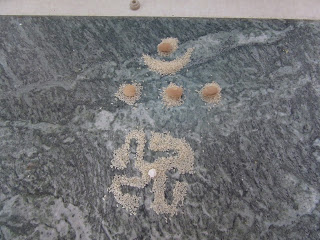





















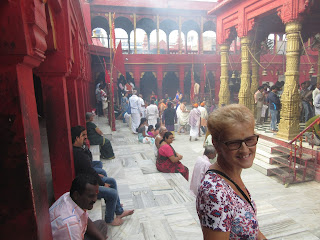
























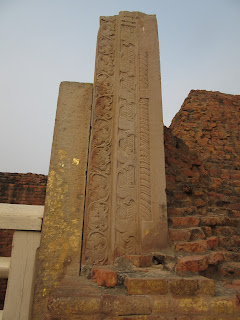
















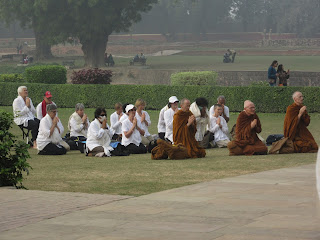












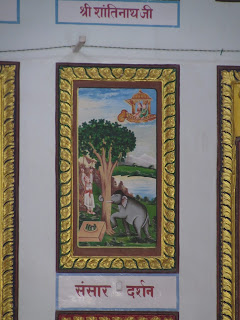















































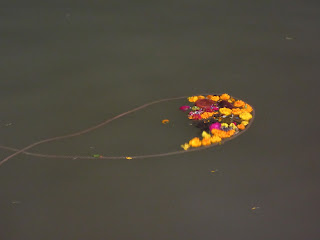















Loved the photo of the women coming down the stairs very early in the day. Lil Red
ReplyDelete